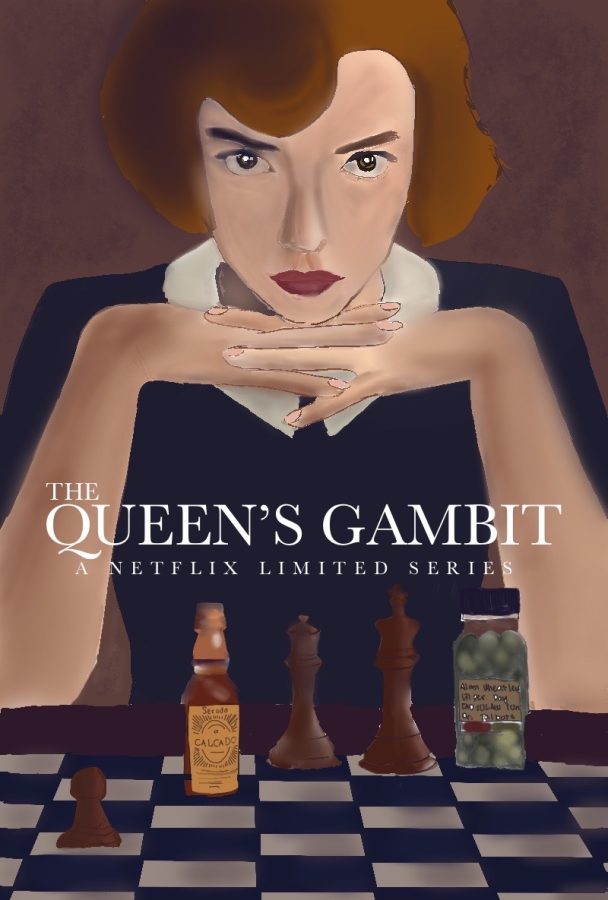“The Queen’s Gambit” television show breaks records, blending glamour with genius
Chess master Beth Harmon concentrates over a chess board of pieces and pills. Netflix limited series “The Queen’s Gambit” broke numerous viewership records and won 11 Emmy awards.
October 17, 2021
When Netflix’s original series “The Queen’s Gambit” launched on Oct. 23, 2020, I didn’t watch the show right away. Over the following weeks, the cover image of a young woman with bright orange hair and pursed red lips posing nonchalantly over a classic chess board overran my feeds. The #1 spot on Netflix’s Top 10 television shows seemed to reserve a spot for “The Queen’s Gambit” for weeks, and world chess champion Magnus Carlsen posted a YouTube video analyzing a game, but this still didn’t convince me to succumb to the hype and watch even an episode of the series.
I only decided to give it a shot when my mom’s college friend recommended that I watch the show. And when I finally watched it, I finished the seven-episode series faster than any other season of a television show. I watched episode one the first day, episodes two and three the second day and episodes four, five and six the third day. I reserved episode seven for a day of its own to savor it.
“The Queen’s Gambit,” a series based off a 1983 novel of the same name by Walter Telvis, certainly deserves all the attention it received—62 million households watched the show in the first 28 days of its release, becoming Netflix’s biggest limited scripted series ever, according to a blog post by Netflix’s Vice President of Original Series, Peter Friedlander. The show even ranked No. 1 in 63 countries and Top 10 in 92 countries.
On top of that, the show won 11 Emmys during the 2021 Primetime Emmy Awards, with a total of 18 nominations. Among these awards are “Outstanding Limited Or Anthology Series” and “Outstanding Directing For A Limited Or Anthology Series Or Movie.” And in my opinion, all of this praise is completely deserved, because “The Queen’s Gambit” has earned a spot in my top three television shows of all time.
The show follows the narrative of a young orphan called Beth Harmon, abandoned by her father, left alone after her mother dies in a car crash in 1958. Growing up at a dreary orphanage, she happens to learn chess from the janitor, William Shaibel, and from there, her skills blossom. She becomes infatuated with the game, skipping class to play, memorizing books of chess openings, mapping out entire games in her head. But the only way she can see the games in her head—insert description here—is after taking a handful of green tranquilizer pills saved from her daily portion of “vitamins”
Lonely wife Alma Wheatley adopts Beth as a teenager, from the orphanage to a household in Lexington, Kentucky, with Beth signing up for chess tournaments in the district. She completes her first state tournament, undefeated, and moves onto nation-wide contests, going largely undefeated. But Beth becomes engulfed with drugs again, especially after her adoptive mother’s death. Even more, throughout the show, she struggles to find respect as a female player in a world of male players.
The series’ intense storytelling perfectly complements the gameplay as well. In fact, in an interview with Slate, Garry Kasparov, the World Chess Champion from 1985 to 2000, said that he could “offer [a] hand, with [his] experience, [his] help, to secure the authenticity of the chess events” throughout the show. He commented that he helped pick out and plan games, including the final game, which was from Patrick Wolff against Vassily Ivanchuk at the Biel Interzonal in 1993.
In one of Carlsen’s YouTube videos analyzing the final game, he describes the intricacies and intelligence of each step that Beth takes against her opponent Vasily Borgov, the reigning champion, and the accuracy of the show overall.
“In general, I felt like the chess was very well done in the series,” Carlsen said in a video. “Lots of game segments I’ve never seen before, and they were quite pretty as well. Watching the series I would predict what was going to happen, I was realising that’s the combination they want to show.”
Other chess professionals in the larger media space felt a similar way, claiming that the show reminded them of their years when competing and their passion for chess. Andrea Botez, a popular chess livestreamer on Twitch, reflects in a YouTube video with her sister about the memories that watching “The Queen’s Gambit” brought back.
“There’s not a single movie or show about chess that made me go, ‘Wow, I want to go compete again,” Andrea said in the discussion. “[Watching “The Queen’s Gambit”] made me miss studying for a tournament and having a really intense game or match with all the pressure and everything.”
Though I personally never became drawn into chess with competitive intentions, I actually created an account on chess.com, a popular website for playing chess with strangers or bots, after completing the show. The website actually made several bots of Beth Harmon at different ages and skill levels that mirror her playing style, though they are now disabled. An article on Towards Data Science mapped the growth of users on chess.com, finding a nearly seven times increase of users in the United Kingdom joining the website in the four-month period after the release of “The Queen’s Gambit” than the four-month period before. Furthermore, according to a Netflix tweet, Google searches of “How to play chess” have peaked for the first time in nine years, and according to a StreamElements tweet, Twitch viewers had watched 4.2 million hours of chess in October of last year, an increase from the 2.4 million hours from October of 2019.
Personally—even more importantly—the series breaks into the still male-dominated field of chess, opening it for females, because historically, there has never been a female world chess champion. However, through a fictional story, viewers can see Beth grapple with her femininity as she grows from an orphaned child to an adult. Her story inspires me, as well, as a female who participates in many male-dominated STEM activities.
Throughout Beth’s chess tournaments, we see her progress from an awkward high schooler to a fashionable, confident young woman. Arriving at her first day of high school, other girls taunt her for her bland and ugly clothing, and Beth gradually becomes more conscious and poised through the episodes. Her clothing reflects the black-and-white of a chess board and popular styles of the 1960s, leading to the show’s Emmys awards for ”Outstanding Period Costumes” and “Outstanding Period And/Or Character Makeup (Non-Prosthetic).” This transition demonstrates how Beth could preserve her genius in the chess realm while pursuing her more feminine side, when some stereotypes may assume that a female can’t have one without the other.
In response to a reporter’s question about accusations of Beth being “too glamourous to be a serious chess player,” she curtly replies, “I would say that it’s much easier to play chess without the burden of an Adam’s Apple.”
The show’s ending and storyline touched me again when I rewatched it for a second time in August this year. This series has topped my personal charts for television shows, and I’m sure I’ll watch it again soon, for the costumes and the set, for the gameplay and the strategy, for the casting and the plot, for the intellect and the feminism.


















![“[Building nerf blasters] became this outlet of creativity for me that hasn't been matched by anything else. The process [of] making a build complete to your desire is such a painstakingly difficult process, but I've had to learn from [the skills needed from] soldering to proper painting. There's so many different options for everything, if you think about it, it exists. The best part is [that] if it doesn't exist, you can build it yourself," Ishaan Parate said.](https://harkeraquila.com/wp-content/uploads/2022/08/DSC_8149-900x604.jpg)




![“When I came into high school, I was ready to be a follower. But DECA was a game changer for me. It helped me overcome my fear of public speaking, and it's played such a major role in who I've become today. To be able to successfully lead a chapter of 150 students, an officer team and be one of the upperclassmen I once really admired is something I'm [really] proud of,” Anvitha Tummala ('21) said.](https://harkeraquila.com/wp-content/uploads/2021/07/Screen-Shot-2021-07-25-at-9.50.05-AM-900x594.png)







![“I think getting up in the morning and having a sense of purpose [is exciting]. I think without a certain amount of drive, life is kind of obsolete and mundane, and I think having that every single day is what makes each day unique and kind of makes life exciting,” Neymika Jain (12) said.](https://harkeraquila.com/wp-content/uploads/2017/06/Screen-Shot-2017-06-03-at-4.54.16-PM.png)








![“My slogan is ‘slow feet, don’t eat, and I’m hungry.’ You need to run fast to get where you are–you aren't going to get those championships if you aren't fast,” Angel Cervantes (12) said. “I want to do well in school on my tests and in track and win championships for my team. I live by that, [and] I can do that anywhere: in the classroom or on the field.”](https://harkeraquila.com/wp-content/uploads/2018/06/DSC5146-900x601.jpg)
![“[Volleyball has] taught me how to fall correctly, and another thing it taught is that you don’t have to be the best at something to be good at it. If you just hit the ball in a smart way, then it still scores points and you’re good at it. You could be a background player and still make a much bigger impact on the team than you would think,” Anya Gert (’20) said.](https://harkeraquila.com/wp-content/uploads/2020/06/AnnaGert_JinTuan_HoHPhotoEdited-600x900.jpeg)

![“I'm not nearly there yet, but [my confidence has] definitely been getting better since I was pretty shy and timid coming into Harker my freshman year. I know that there's a lot of people that are really confident in what they do, and I really admire them. Everyone's so driven and that has really pushed me to kind of try to find my own place in high school and be more confident,” Alyssa Huang (’20) said.](https://harkeraquila.com/wp-content/uploads/2020/06/AlyssaHuang_EmilyChen_HoHPhoto-900x749.jpeg)











